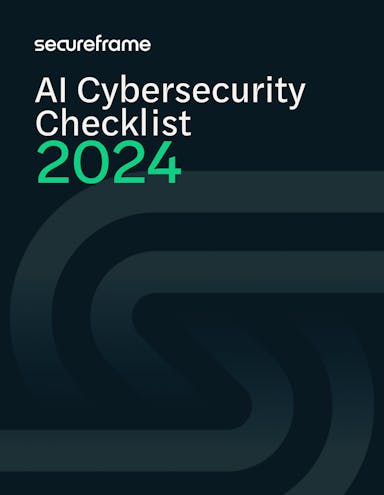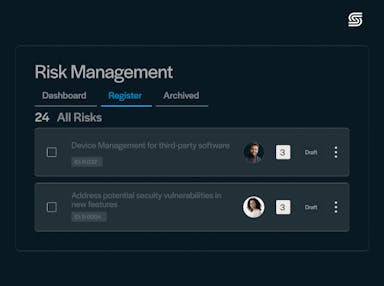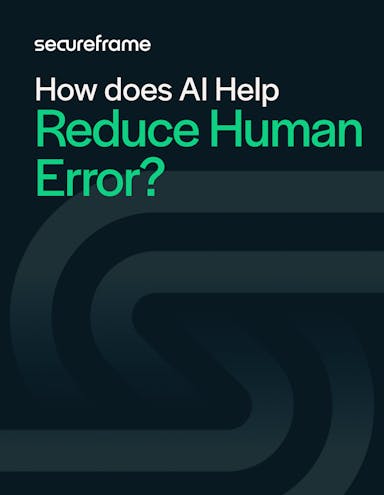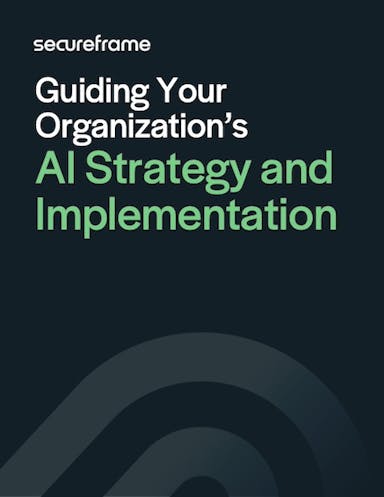
AI in Cybersecurity: Latest Developments + How It's Used in 2025
Anna Fitzgerald
Senior Content Marketing Manager
Emily Bonnie
Senior Content Marketing Manager
Artificial intelligence (AI) and machine learning have powered cybersecurity tools for decades, from anti-virus and spam filtering to phishing detection. But in 2024 and 2025, we’ve seen a major shift. Generative AI has moved from experimentation to mainstream enterprise deployment, fueling a surge in new product releases, record-high investments, and heightened debate over the risks and benefits of AI in cybersecurity.
To understand how AI is shaping cybersecurity in 2025 and beyond, we'll explain how AI is used in cybersecurity today, the benefits it provides, the latest developments, and how attackers are also exploiting AI.
How is AI used in cybersecurity?
AI is used in cybersecurity to automate tasks that are highly repetitive, manually-intensive, and tedious for security analysts and other experts to complete. This frees up time and resources so cybersecurity teams can focus on more complex security tasks like policymaking.

Take endpoint security for example. Endpoint security refers to the measures an organization puts in place to protect devices like desktops, laptops, and mobile devices from malware, phishing attacks, and other threats. To supplement the efforts of human experts and policies they put in place to govern endpoint security, AI can learn the context, environment, and behaviors associated with specific endpoints as well as asset types and network services. It can then limit access to authorized devices based on these insights, and prevent access entirely for unauthorized and unmanaged devices.
Since AI can enhance other areas of cybersecurity as well, there is expected to be an explosion in AI-based cybersecurity products. By the end of 2024, the global AI in cybersecurity market was valued at more than $25 billion, and analysts project it will exceed $230 billion by 2032.
Before taking a closer look at the use of AI in cybersecurity, let’s take a closer look at the benefits.
Benefits of AI in Cybersecurity
Cybersecurity presents unique challenges, including a constantly evolving threat landscape, vast attack surface, and significant talent shortage.
Since AI can analyze massive volumes of data, identify patterns that humans might miss, and adapt and improve its capabilities over time, it has significant benefits when applied to cybersecurity, including:
- Improving the efficiency of cybersecurity analysts
- Identifying and preventing cyber threats more quickly
- Effectively responding to cyber attacks
- Reducing cybersecurity costs
Consider the impact of security AI and automation on average data breach costs and breach lifecycles alone. According to IBM’s 2024 report, organizations that extensively deploy AI and automation reduced the average breach cost by $2.2 million compared to those without, and contained breaches 127 days faster on average.

Even organizations with limited use of security AI and automation reported an average cost of a data breach of $4.04 million, which was $1.32 million less or a 28.1% difference compared to no use. Organizations with limited use also saw a significant acceleration in the time to identify and contain a breach, with an average of 88 days faster than organizations with no use of security AI and automation.
To better understand the impact of AI on cybersecurity, let’s take a look at some specific examples of how AI is used in cybersecurity below.
Recommended reading

35+ AI Statistics to Better Understand Its Role in Cybersecurity [2023]
AI in cybersecurity examples
Many organizations are already using AI to help make cybersecurity more manageable, more efficient, and more effective. Below are some of the top applications of AI in cybersecurity.
1. Threat detection
Threat detection is one of the most common applications of AI in cybersecurity. AI can collect, integrate, and analyze data from hundreds and even thousands of control points, including system logs, network flows, endpoint data, cloud API calls, and user behaviors. In addition to providing greater visibility into network communications, traffic, and endpoint devices, AI can also recognize patterns and anomalous behavior to identify threats more accurately at scale.
For example, legacy security systems analyzed and detected malware based on signatures only whereas AI- and ML-powered systems can analyze software based on inherent characteristics, like if it’s designed to rapidly encrypt many files at once, and tag it as malware. By identifying anomalous system and user behavior in real time, these AI- and ML-powered systems can block both known and unknown malware from executing, making it a much more effective solution than signature-based technology.
2. Threat management
Another top application of AI in cybersecurity is threat management.
A survey by Orca Security found that 59% of organizations receive more than 500 cloud security alerts per day, and 38% get over 1,000. Nearly half of IT decision makers reported that over 40% of those alerts are false positives, while another 49% said that more than 40% are low priority. Even though 56% of respondents spend over a fifth of their workday reviewing alerts and deciding which to address, more than half admitted their teams have missed critical alerts in the past due to poor prioritization.
This results in a range of issues, including missed critical alerts, time wasted chasing false positives, and alert fatigue which contributes to employee turnover.
In order to combat these issues, organizations can use AI and other advanced technologies like machine learning to supplement the efforts of these human experts. AI can scan vast amounts of data to identify potential threats and filter out non-threatening activities to reduce false positives at a scale and speed that human defenders can’t match.
By reducing the time required to analyze, investigate, and prioritize alerts, security teams can spend more time remediating these alerts, which takes three or more days on average according to 46% of respondents in the Orca Security survey.
3. Threat response
AI is also used effectively to automate certain actions to speed up incident response times. For example, AI can be used to automate response processes to certain alerts. Say a known sample of malware shows up on an end user’s device. Then an automated response may be to immediately shut down that device’s network connectivity to prevent the infection from spreading to the rest of the company.
AI-driven automation capabilities can not only isolate threats by device, user, or location, they can also initiate notification and escalation measures. This enables security experts to spend their time investigating and remediating the incident.

AI Cybersecurity Checklist
Download this checklist for more step-by-step guidance on how you can harness the potential of AI in your cybersecurity program.
Latest developments in cybersecurity AI (2025)
When asked what they would like to see more of in security in 2023, the top answer among a group of roughly 300 IT security decision makers was AI. Many cybersecurity companies are already responding by ramping up their AI-powered capabilities.
Let’s take a look at some of the latest innovations below.
1. AI-powered remediation
More advanced applications of AI are helping security teams remediate threats faster and easier. Some AI-powered tools today can process security alerts and offer users step-by-step remediation instructions based on input from the user, resulting in more effective and tailored remediation recommendations.
Secureframe Comply AI does just that for failing cloud tests. Using infrastructure as code (IaC), Comply AI for remediation automatically generates remediation guidance tailored to users’ environment so they can easily update the underlying issue causing the failing configuration in their environment. This enables them to fix failing controls to pass tests, get audit-ready faster, and improve their overall security and compliance posture.
Recommended reading

Introducing Secureframe Comply AI: Faster, Tailored Cloud Remediation
2. Enhanced threat intelligence using generative AI
Generative AI is increasingly being deployed in cybersecurity solutions to transform how analysts work. Rather than relying on complex query languages, operations, and reverse engineering to analyze vast amounts of data to understand threats, analysts can rely on generative AI algorithms that automatically scan code and network traffic for threats and provide rich insights.
Google’s Cloud Security AI Workbench is a prominent example. This suite of cybersecurity tools is powered by a specialized AI language model called Sec-PaLM and helps analysts find, summarize, and act on security threats. Take VirusTotal Code Insight, which is powered by Security AI Workbench, for example. Code Insight produces natural language summaries of code snippets in order to help security experts analyze and explain the behavior of malicious scripts. This can enhance their ability to detect and mitigate potential attacks.
Recommended reading

Generative AI in Cybersecurity: How It’s Being Used + 8 Examples
3. Security questionnaire automation via generative AI
Security questionnaires are a common way to vet potential vendors and other third parties to assess whether their cybersecurity practices meet internal and external requirements. While these are important for vendor risk management, they can take up valuable time. AI can help speed up this process by suggesting answers based on previously answered questionnaires. Some more powerful AI tools can even pull from an organization's security policies and controls when suggesting answers to be as accurate as possible.
Secureframe Questionnaire Automation, for example, uses generative AI to suggest answers that draw from an organization's policies, tests, and controls as well as previous responses stored in their Knowledge Base to further enhance accuracy and time savings for users. It’ll even rephrase answers using context hosted in their Knowledge Base. By leveraging AI to automate the collection of answers to security questionnaires from multiple sources and intelligently parse and rephrase responses, this AI solution ensures that answers are consistent, accurate, and tailored to the specific requirements of each question and helps save organizations hundreds of hours answering tedious security questionnaires.
4. Stronger password security using LLMs
According to new research, AI can crack most commonly used passwords instantly. For example, a study by Home Security Heroes proved that 51% of common passwords can be cracked by AI in under a minute.
While scary to think of this power in the hands of hackers, AI also has the potential to improve password security in the right hands. Large language models (LLMs) trained on extensive password breaches like PassGPT have the potential to enhance the complexity of generated passwords as well as password strength estimation algorithms. This can help improve individuals’ password hygiene and the accuracy of current strength estimators.
5. Dynamic deception capabilities via AI
While malicious actors will look to capitalize on AI capabilities to fuel deception techniques such as deepfakes, AI can also be used to power deception techniques that defend organizations against advanced threats.
Deception technology platforms are increasingly implementing AI to deceive attackers with realistic vulnerability projections and effective baits and lures. Acalvio’s AI-powered ShadowPlex platform, for example, is designed to deploy dynamic, intelligent, and highly scalable deceptions across an organization’s network.
6. Simplified vendor questionnaires using AI
Vendor assessments are a crucial aspect of vendor risk management, helping organizations assess the security practices, compliance, and risks of potential vendors before establishing business relationships. Traditionally, these assessments have been manual processes that take up a significant amount of an organization’s time and resources. Since AI is capable of analyzing massive amounts of data much faster than humans can, AI tools can significantly simplify and speed up vendor assessments.
Comply AI for VRM, for example, streamlines the security assessment process. Secureframe customers can not only send custom or template-based questionnaire templates directly from the Secureframe platform and have vendor responses be posted back in the platform automatically for centralized management — they can also use Comply AI for VRM to automatically extract relevant answers from hosted vendor documents, like SOC 2 reports. This saves vendors time from having to respond to every single question, enhancing the efficiency and accuracy of security reviews.
7. AI-assisted development
In 2023, CISA published a set of principles for the development of secure by design products. The goal is to reduce breaches, improve the nation’s cybersecurity, and reduce developers’ ongoing maintenance and patching costs. However, it will likely increase development costs.
As a result, developers are starting to rely on AI-assisted development tools to reduce these costs and improve their productivity while creating more secure software. GitHub Copilot is a relatively new but promising example. In a survey of more than 2,000 developers, developers who used GitHub Copilot completed a task 55% faster than the developers who didn’t.
8. AI-based patch management
As hackers continue to use new techniques and technologies to exploit vulnerabilities, manual approaches to patch management can’t keep up and leave attack surfaces unprotected and vulnerable to data breaches. Research in Action1’s 2023 State of Vulnerability Remediation Report found that 47% of data breaches resulted from unpatched security vulnerabilities, and over half of organizations (56%) remediate security vulnerabilities manually.
AI-based patch management systems can help identify, prioritize, and even address vulnerabilities with much less manual intervention required than legacy systems. This allows security teams to reduce risk without increasing their workload.
For example, GitLab recently released a new security feature that uses AI to explain vulnerabilities to developers — with plans to expand this to automatically resolve them in the future.
9. Automated penetration testing
Penetration testing is a complex, multi-step process that involves gathering information about a company’s environment, identifying threats and vulnerabilities, and then exploiting those vulnerabilities to try to gain access to systems or data. AI can help simplify these parts of the process by quickly and efficiently scanning networks and gathering other data and then determining the best course of action or exploitation pathway for the pen tester.
Although a relatively nascent area of AI cybersecurity, there are already a mix of open-source tools like DeepExploit and proprietary tools like NodeZero offering a faster, more affordable, and scaleable alternative to traditional penetration testing services. DeepExploit, for example, is a fully automated penetration testing tool that uses machine learning to enhance several parts of the pen testing process, including intelligence gathering, threat modeling, vulnerability analysis, and exploitation. However, it is still in beta mode.
10. AI-powered risk assessments
AI is also being used to automate risk assessments, improving accuracy and reliability and saving cybersecurity teams significant time. These types of AI tools can evaluate and analyze risks based on existing data from a risk library and other data sources, and automatically generate risk reports.
Secureframe Comply AI for Risk, for example, can produce detailed insights into a risk with a single click, leveraging only a risk description and company information. This AI-powered solution can determine the likelihood and impact of a risk before a response, suggest a treatment plan to respond to the risk, and define the residual likelihood and impact of the risk after treatment. These detailed outputs from Comply AI for Risk help organizations better understand the potential impact of a risk and proper mitigation methods, improving their risk awareness and response.
11. AI-driven insider threat detection
Hybrid and remote work has expanded insider risk. In 2025, AI tools are increasingly trained to spot unusual user behavior patterns that may indicate credential misuse or insider threats before they escalate.
For example, Microsoft Purview Insider Risk Management and Varonis have added AI-driven behavioral analytics to help security teams spot suspicious actions, such as an employee suddenly downloading large amounts of sensitive files outside normal work hours. These insights help organizations intervene early, before a potential insider incident escalates into a breach.
12. AI + Zero trust access control
Zero trust is no longer just about static policies and MFA prompts. In 2025, AI is powering adaptive, context-aware access decisions. Instead of simply verifying credentials, AI models now factor in device health, geolocation, user behavior, and network activity in real time before granting access.
Cisco’s Duo Trust Monitor uses machine learning to detect abnormal login behavior, while Okta’s AI-powered Adaptive MFA adjusts authentication requirements based on user risk. These AI enhancements make zero trust frameworks more dynamic, reducing friction for legitimate users while tightening defenses against sophisticated attackers.
13. AI for red teaming and adversarial testing
AI is also reshaping how organizations test their defenses. Traditionally, red-team exercises required significant time and expertise to map attack surfaces and develop attack chains. Now, AI-powered tools like Cymulate’s Breach and Attack Simulation platform and research projects like DeepExploit are enabling teams to automatically probe networks, identify potential vulnerabilities, and simulate realistic attack paths at scale.
Some security consultancies are even experimenting with LLM-based adversarial testing, where AI models generate phishing campaigns or plan lateral movement strategies to expose weaknesses human testers might overlook. This accelerates testing cycles and helps organizations identify blind spots faster.
Recommended reading

Confidently Grow Your Organization and Reduce Risk with Secureframe’s New Risk Management
AI and cybercrime
While AI is being applied in many ways to improve cybersecurity, it is also being used by cyber criminals to launch increasingly sophisticated attacks at an unprecedented pace.
In fact, 85% of security professionals that witnessed an increase in cyber attacks over the past 12 months attribute the rise to bad actors using generative AI.
Cybercrime is projected to cost $10.5 trillion annually by 2025, with AI expected to be a major accelerant.
Below are just a few ways that AI is being used in cybercrime:
- FraudGPT and WormGPT were actively sold on dark web forums in 2024, offering criminals ready-made tools for phishing and malware generation.
- AI-generated deepfakes were used in some of the biggest data breaches of 2024, including one where a finance worker was tricked into transferring $25 million after a video call with a fake CFO.
- AI-powered ransomware is mutating faster than signature-based defenses can keep up, with security firms reporting a significant increase in polymorphic ransomware attacks in 2024.
- Hackers are using AI-supported password guessing and CAPTCHA cracking to gain unauthorized access to sensitive data.
- Threat actors are creating AI that can autonomously identify vulnerabilities, plan and carry out attack campaigns, use stealth to avoid defenses, and gather and mine data from infected systems and open-source intelligence.
Organizations that extensively use AI and automation to enhance their cybersecurity capabilities will be best positioned to defend against the weaponized use of AI by cybercriminals. In a study by Capgemini Research Institute, 69% of executives say that AI results in higher efficiency for cybersecurity analysts in the organization. 69% also believe AI is necessary to effectively respond to cyberattacks. Find more statistics about the positive impact of AI in cybersecurity.

How Does AI Reduce Human Error in Cybersecurity?
This ebook provides a high-level overview of the crucial role AI is playing in mitigating risks of data breaches, regulatory violations, financial losses, and more, using examples of real-world applications in cybersecurity and IT compliance.
How is cybersecurity AI being improved?
In response to these emerging threats, cybersecurity AI is being continuously improved to keep pace with cybercriminals and adapt its capabilities over time.
Below are key ways in which cybersecurity AI is being improved.
1. Better training for AI models
AI models are getting better training thanks to increased computation and training data size. As these models ingest greater amounts of data, they have more examples to learn from and can draw more accurate and nuanced conclusions from the examples it is shown.
As a result, cybersecurity AI tools are better at identifying patterns and anomalies in large datasets and learning from past incidents, which enables them to more accurately predict potential threats, among other cybersecurity use cases.
2. Advances in language processing technology
Thanks to increases in data resources and computing power, language processing technology has made significant advances in the past few years. In 2025, natural-language threat queries are now embedded directly in SIEM platforms like Microsoft Sentinel and Google Chronicle, enabling analysts to ask questions in plain English and get instant insights.
These advances, including enhanced capabilities to learn from complex and context-sensitive data, will significantly improve cybersecurity AI tools that automatically generate step-by-step remediation instructions, threat intelligence, and other code or text.
3. Threat intelligence integration
Cybersecurity AI systems are being enhanced by integrating with threat intelligence feeds. This enables them to stay updated on the latest threat information and adjust their defenses accordingly.
4. Deep learning
A subset of machine learning, deep learning is a neural network with three or more layers. Simulating the behavior of the human brain, these neural networks attempt to learn from large amounts of data and make more accurate predictions than a neural network with a single layer.
Due to its ability to process vast amounts of data and recognize complex patterns, deep learning technology is helping contribute to more accurate threat hunting, management, and response.
5. More resources for AI development and use
As AI development and usage continue to skyrocket in cybersecurity and other industries, governments and other authoritative bodies like NIST, CISA, and OWASP are publishing resources to help individuals and businesses manage the risks while leveraging the benefits. These resources will help provide developers with best practices for improving AI in cybersecurity and beyond. Some examples include:
Recommended reading

190 Cybersecurity Statistics to Inspire Action This Year
Harnessing the power of AI in your cybersecurity strategy
Over the last few years, AI in cybersecurity has quickly moved from concept to critical capability. From automating risk assessments to strengthening zero trust defenses, AI tools are reshaping how organizations defend themselves.
At Secureframe, we're committed to making these advancements accessible. Our latest AI innovations help organizations strengthen their security and compliance programs while saving valuable time and resources:
- Comply AI for AI Security Assessments: Provides a standardized approach to assessing vendor AI risk.
- Comply AI for Vendor Risk Management: Extracts key information from third-party reports like SOC 2 reports to simplify vendor reviews.
- Comply AI for Remediation: Automatically generates infrastructure-as-code fixes for failing cloud tests.
- Comply AI for Risk: Analyzes risk descriptions and creates detailed treatment plans with scoring.
- Comply AI for Policies: Uses generative AI to draft and customize security and compliance policies.
- Trust AI for Questionnaire Automation: Automatically drafts accurate responses to RFPs and due diligence requests — powered by the most data sources and smarter context-aware answer generation.
- AI Evidence Validation: Automatically verify documentation accuracy before audits and assessments begin, reducing audit findings and exceptions.
To learn more about how Secureframe uses automation and AI to simplify security and compliance, schedule a demo.

Guiding Your Organization's AI Strategy and Implementation
Follow these best practices to effectively implement AI while addressing concerns related to transparency, privacy, and security.
FAQs
How is AI being used in cybersecurity?
AI is being used in cybersecurity to supplement the efforts of human experts by automating tasks that are highly repetitive, manually-intensive, and tedious for them to complete. Since AI can analyze massive volumes of data, identify patterns that humans might miss, and adapt and improve its capabilities over time, it excels at threat detection, threat management, threat response, endpoint security, and behavior-based security.
What is responsible AI in cyber security?
Responsible AI in cybersecurity refers to the design and deployment of safe, secure, and trustworthy artificial intelligence in the industry. The goal is to increase transparency and reduce risks like AI bias by promoting the adoption of specific best practices, such as red-team testing.
How are AI and machine learning changing the cybersecurity landscape?
AI and machine learning are being used to strengthen cybersecurity in unprecedented ways, like flagging concealed anomalies, identifying attack vectors, and automatically responding to security incidents. They are also being used to launch increasingly sophisticated and frequent cyber attacks as well.
Use trust to accelerate growth

Anna Fitzgerald
Senior Content Marketing Manager
Anna Fitzgerald is a digital and product marketing professional with nearly a decade of experience delivering high-quality content across highly regulated and technical industries, including healthcare, web development, and cybersecurity compliance. At Secureframe, she specializes in translating complex regulatory frameworks—such as CMMC, FedRAMP, NIST, and SOC 2—into practical resources that help organizations of all sizes and maturity levels meet evolving compliance requirements and improve their overall risk management strategy.

Emily Bonnie
Senior Content Marketing Manager
Emily Bonnie is a seasoned digital marketing strategist with over ten years of experience creating content that attracts, engages, and converts for leading SaaS companies. At Secureframe, she helps demystify complex governance, risk, and compliance (GRC) topics, turning technical frameworks and regulations into accessible, actionable guidance. Her work aims to empower organizations of all sizes to strengthen their security posture, streamline compliance, and build lasting trust with customers.